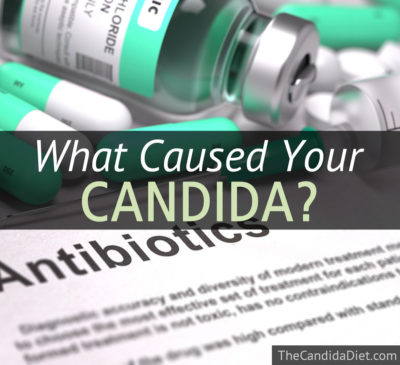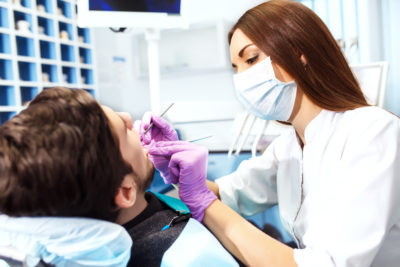The 7 Most Common Causes Of Candida

What triggered your Candida? Was it your diet, a course of antibiotics, or a prolonged period of stress?
The causes of Candida include a high sugar diet, antibiotics, chronic stress, the contraceptive pill, chemical exposure, and diabetes. Usually, two or more of these triggers are to blame. For example, a diet full of inflammatory foods and sugars is more likely to cause a Candida overgrowth when combined with a course of antibiotics.
It’s important to realize that most people have Candida albicans in their digestive tract already. It is a microorganism that is naturally present in your gut, part of the balanced system that helps you to digest food and stay fit and well.
When people talk about Candida, they are really talking about the excess growth of Candida. So if it’s not something that you ‘catch’ like a virus, what causes it?
Candida Related Complex is still in the early stages of being recognized by the medical community, but there has been a surprising amount of research conducted into this illness. The consensus is leaning towards a handful of medical and lifestyle factors that seem to be triggers for a Candida overgrowth.
Are you are suffering from multiple Candida symptoms and looking to get your health back? Here are a few of the things that might be causing your health problems.
Table Of Contents
1. A High-Sugar Diet
 The modern diet provides huge amounts of the sugar that Candida albicans needs to survive and thrive. That includes sugar itself, foods containing sugar, and also anything that converts to sugar. Refined carbohydrates, like white flour, and even fruits can all contribute to Candida overgrowth.
The modern diet provides huge amounts of the sugar that Candida albicans needs to survive and thrive. That includes sugar itself, foods containing sugar, and also anything that converts to sugar. Refined carbohydrates, like white flour, and even fruits can all contribute to Candida overgrowth.
Organisms like Candida albicans need organic, carbon-based compounds to provide them with energy. In practice this means sugars like glucose, fructose, and sucrose. They use this energy to grow and to build their cell walls, which are comprised 80% of carbohydrates. Candida also uses sugar to switch to its pathogenic, fungal form, and to construct the biofilms that protect it from your immune system.
A healthy immune system should be able to keep Candida at bay. However, a diet rich in sugar works to depress your immune system, leaving it vulnerable and allowing the Candida yeast to proliferate. If you’re suffering from Candida symptoms like brain fog, yeast infections, and digestive issues, reducing the sugar in your diet should be one of your main priorities.
2. Antibiotics
 Antibiotics are perhaps the most common culprit for a Candida overgrowth. They are lifesavers, but they come with plenty of side effects.
Antibiotics are perhaps the most common culprit for a Candida overgrowth. They are lifesavers, but they come with plenty of side effects.
A course of antibiotics will likely kill the harmful bacteria for which it is prescribed, but it also destroys many of the beneficial and friendly bacteria that live in your gut. This army of bacteria plays a vitally important role in your immune system. Disturbing it can leave your body defenseless to harmful bacteria and fungi, such as the fast-growing Candida fungus that can quickly dominate the gut.
Of course there are times when you really do need that antibiotics prescription, but the truth is that doctors prescribe it for many health issues unnecessarily, like the common cold or a sore throat. Make sure there is no alternative treatment to your condition and, if you must take antibiotics, be sure to take a good probiotic supplement during and after the treatment to replenish your healthy bacteria population.
Buying organic food can help to reduce your exposure to antibiotics. An astounding 55% of the antibiotics used in the US are in the livestock industry. Herds of cattle are fed antibiotics to keep mortality rates low and profit margins high. Some of these residual antibiotics make their way on to our plates in foods like beef and milk. This has become so widespread that the European Union has banned it completely, and won’t even import beef that has been raised with antibiotics.
3. Chronic Stress
 Stress affects your body in two ways, both of which can lead to excess Candida. One of your body’s first reactions to a stressful situation is to release cortisol, a hormone that depresses your immune system and raises your blood sugar level. The Candida yeast feeds on the extra sugar, while your weakened immune system is powerless to stop it. Stress gives it the chance to overpower the existing gut flora in your small intestine.
Stress affects your body in two ways, both of which can lead to excess Candida. One of your body’s first reactions to a stressful situation is to release cortisol, a hormone that depresses your immune system and raises your blood sugar level. The Candida yeast feeds on the extra sugar, while your weakened immune system is powerless to stop it. Stress gives it the chance to overpower the existing gut flora in your small intestine.
Studies have shown that psychological stress can quickly change the colonization patterns of microorganisms in your gut. And animal studies have shown how stress can lead to reduced diversity in the gut flora. Although the mechanism is not clear, emotional stress allows certain strains to colonize more effectively and aggressively than others. For this reason, some doctors recommend taking probiotics to counteract the effects of chronic stress.
4. The Contraceptive Pill
 In other sufferers, an outbreak of Candida can be traced to the contraceptive pill. The intestines are delicate organs, containing a broad mixture of microorganisms and yeasts that all help to process and digest food. They depend on the right environment to support them, and this equilibrium can be thrown off by the hormonal imbalances caused by the contraceptive pill.
In other sufferers, an outbreak of Candida can be traced to the contraceptive pill. The intestines are delicate organs, containing a broad mixture of microorganisms and yeasts that all help to process and digest food. They depend on the right environment to support them, and this equilibrium can be thrown off by the hormonal imbalances caused by the contraceptive pill.
By disturbing this balance, the contraceptive pill opens the door for Candida to once again outgrow its competitors in the gut. Estrogen, the major ingredient in the contraceptive pill, is known to promote the growth of yeast. If you need evidence of how this can happen, see how many women get regular yeast infections while on the pill. It’s exactly the same principle, and it has been documented by multiple research studies.
Another contraceptive device that may contribute to a Candida infestation is the copper IUD. It has been shown that copper can increase yeast growth in much the same way as estrogen does. So be very aware of these problems when choosing your contraceptive technique!
5. Mercury In Your Fillings

The old-style silver amalgam fillings contain at least 50% mercury, and this is poisonous to the body. Mercury particles and vapor are continuously released in the body as you chew, grind and brush your teeth.
Mercury toxicity affects sufferers of Candida overgrowth in two ways.
Firstly, it worsens some of the symptoms associated with Candida Related Complex. Because mercury is a neurotoxin, it can cause symptoms like brain fog, fatigue, and memory loss, which are precisely the symptoms that you might be suffering from already as a result of your Candida infestation.
Secondly, mercury has been shown to weaken the immune system. This allows the Candida population to flourish without the usual immune cells working to slow it down, and also prevents recovery from a sustained Candida infestation.
There is no safe level of mercury to have in your system, so keeping it in your mouth is definitely a bad idea. If you can afford it, do take charge of your health and have them replaced by a dentist trained in mercury-removal techniques.
6. Chemical Exposure
 Chemicals that are added to drinking water, such as chlorine and fluoride, can kill the beneficial bacteria in your gut. This weakens your immune system and has the potential to allow a small number of Candida yeast cells in your gut to grow into a Candida infestation.
Chemicals that are added to drinking water, such as chlorine and fluoride, can kill the beneficial bacteria in your gut. This weakens your immune system and has the potential to allow a small number of Candida yeast cells in your gut to grow into a Candida infestation.
Chlorine in particular can be found almost everywhere you look. Most cities add chlorine to their drinking water. This mean that you are drinking chlorine every day, bathing in it, showering in it, and using it to wash the clothes that you and your family wear. As a powerful disinfectant, it ensures that the water supply stays free of pathogens. However, the health benefits are outweighed by chlorine’s effect on your gut flora and immune system.
Luckily there are ways to reduce your chlorine exposure. Once you add some filters in your house and switch to more natural laundry products, your body will take in much less of this poisonous chemical.
There are other chemicals that can deplete the immune system too. People who regularly work with toxic chemicals are particularly at risk for a weakened immune system and greater susceptibility to Candida. This can include people who work as hair stylists, painters, dry cleaners, or in industrial settings. They are exposed to a much greater toxic load than the rest of us, and this can have consequences for their immune system and their health. The more exposed they are, the more vulnerable they might be to pathogens like Candida.
7. Diabetes
 Sufferers of diabetes are more likely to experience repeated yeast infections for two reasons.
Sufferers of diabetes are more likely to experience repeated yeast infections for two reasons.
The first reason is that diabetics have high blood sugar levels that feed the Candida yeast cells. This is either due to a shortage of insulin production in the body or because the body is not reacting to insulin as it should.
The second reason is the weakened immune system that is one of the symptoms of diabetes. According to a British study published in 2011, this is because the high levels of glucose effectively ‘blind’ the receptors in your immune system that identify pathogens. This allows the Candida yeast cells to multiply and transform into their fungal, pathogenic form.
Do you know what caused your Candida? For lots more information on this, as well as how to develop a personalized treatment plan, check out the Ultimate Candida Diet program. I wrote it with Dr Eric Wood and it contains all you need to know to beat your Candida.

3-Month Candida Elimination Kit Start Your 3-month Candida Cleanse
This Candida Kit contains all the supplements recommended on the Candida Diet:
- LIVER ONE to process and remove the toxins created by Candida.
- CANDASSIST to inhibit and weaken the Candida colonies in your gut.
- PROBIOTIC to replace the Candida yeast with probiotic bacteria.
Plus... the CANDIDA DIET RECIPE BOOK with 50+ low-sugar recipes

Leave a Reply